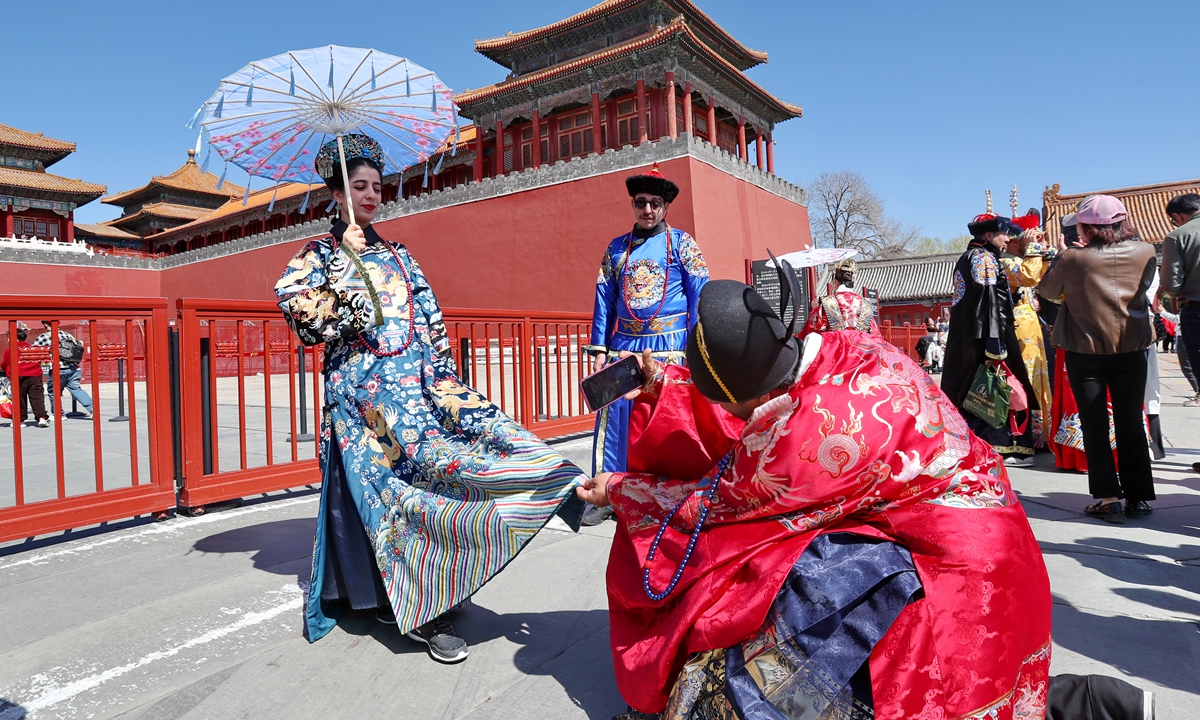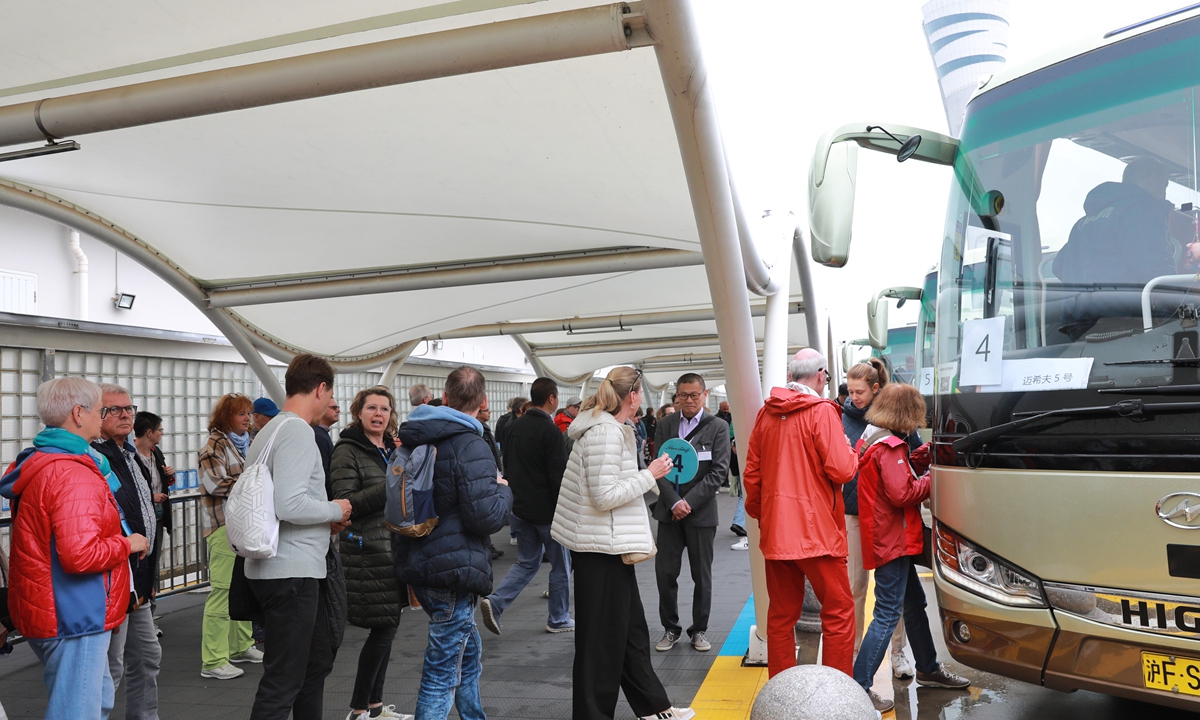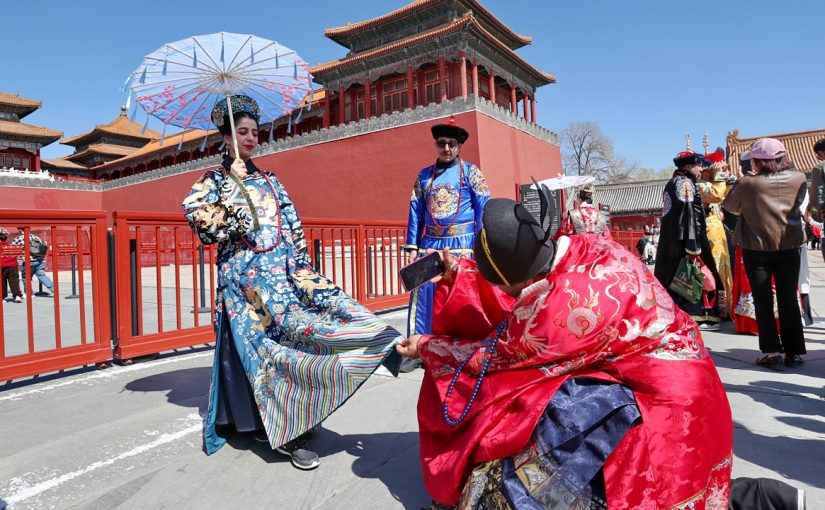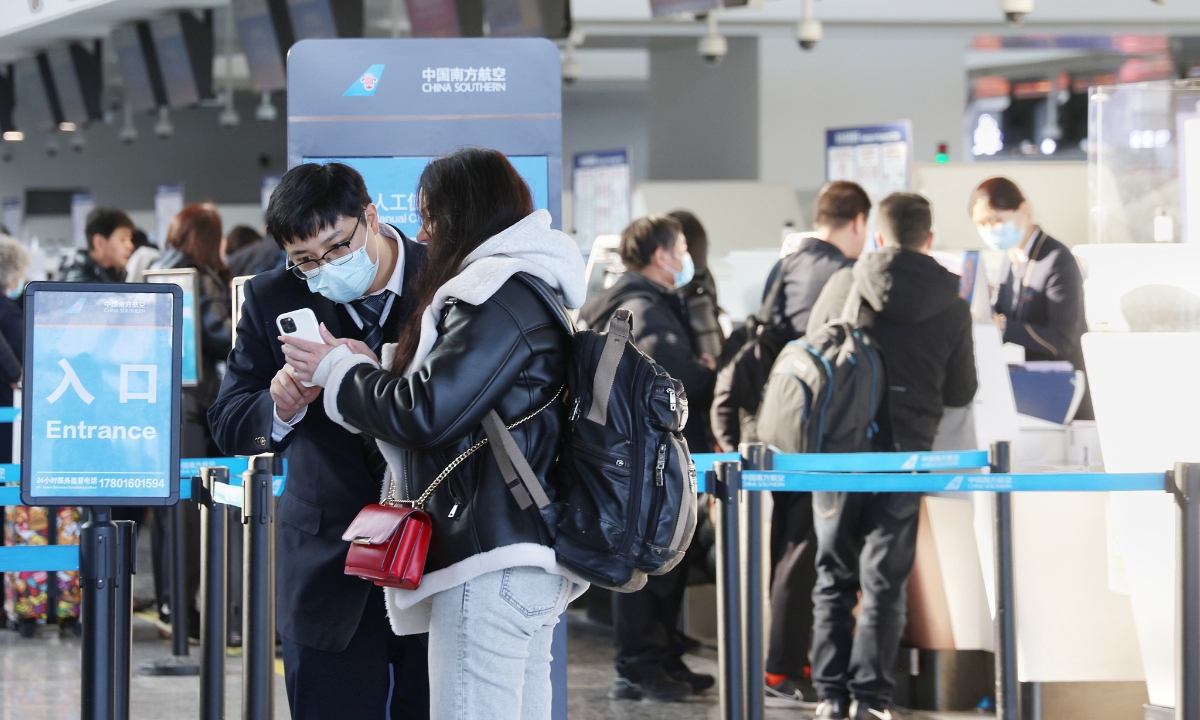
Foreign tourists wearing traditional costumes visit the Forbidden City to experience traditional Chinese culture in Beijing on March 22, 2024. Photo: VCG
Skyscrapers fill the screen. Under the intensive high-rise buildings, Mac Candee and his friend walk on the street. “Today, we have arrived in Shanghai, China.” They say, angling the camera to show a view of their surroundings.
Then, there come clips of Western media reporting on China, with some negative tones that overseas audiences have probably been very familiar with. Only seconds later, Candee reappears on the screen: He stands at The Bund in downtown Shanghai, and behind him is the Huangpu River glistening under the clear blue sky.
“We’re going to be showing you if what you’re told in the media and what you know about China actually match up with what life is like here,” Candee says to the camera.
This is a four-hour video about Candee’s Shanghai trip that he made after he had stayed in the city for six days.
Candee, a 31-year-old US travel vlogger whose accounts “WorldNomac” have some 2.5 million followers on various social media platforms, is among a surging number of foreign tourists coming to China after the country relaxed its entry policies in recent months.
2024 has become a remarkable year for inbound tourism, since China expanded its 144-hour visa-free transit policy to more countries. In some major transit stops and also tourist destinations, like Beijing, Shanghai, and Chengdu, visitors from different countries and regions carrying travel bags and cameras flood landmarks and popular restaurants in these cities. They have become witnesses of China’s prosperous tourism market, and have provided some vivid, individual windows for the world to take a closer look at this big Eastern country.

Inbound tourists have a photo taken with a lion dancer on April 6, 2024. Photo: VCG
1st time in China
Months ago, in preparation for his trip to the Philippines, Candee happened to see a YouTube video showing the process of doing a 144-hour transit visa, and learned that visitors from certain countries no longer have to go to an embassy or consulate for a tourist visa to China.
The video inspired Candee to add “China” to his itinerary. “I was like, Oh, I’m actually going to the Philippines. This would be a great time to also at least visit Shanghai and see what China is like,” he recalled.
Candee had always wanted to visit China. He told the Global Times that China has always been a very interesting country for him with how massive it is, and how big of a percentage of the world’s population is from China. “I wanted to get a small taste of what the culture was like over there,” he said.
In his Shanghai trip vlog, Candee showed how he explored many aspects of the metropolis with his friends. They went to Shanghai’s iconic places like the Bund, the Oriental Pearl Tower, and Jing’an Temple, and tasted lots of food including
sheng jian bao (pan-fried pork bun), hot pot, and a McDonald’s restaurant with localized food. They experienced the city’s public transport from metro trains to the maglev, and talked to many local residents.
As the first stop for many overseas tourists’ trips to China, Shanghai is “a melting pot for multiple cultures” in Candee’s eyes. “It’s a very beautiful city from the standpoint of there’s so much modern architecture, but then you’ll see temples built into the city as well, so you get a mix of old times and new times and modern living,” he told the Global Times. Candee added that he also encountered lots of similar European architectural styles with a Chinese twist.
A frequent global traveler, Candee said that in Shanghai he didn’t encounter massive challenges brought about by cultural differences. Some interesting experiences nonetheless gave him a unique angle to know about Chinese people.
During his stay in Shanghai, Candee went to the “marriage market” in People’s Park, a regular matchmaking venue where locals look for spouses for themselves as well as for their adult children.
“I thought that was fascinating, that parents of Chinese people will go and essentially advertise all of their children’s qualifications without a photo in order to look for a husband or a wife for them,” he recalled.
“This, for me, was a big culture shock to learn about how they do that, and it was really cool to go and experience that.”
Candee concluded that he likes Shanghai, as “there’s so much to do there.”
His love for this city was somewhat reflected in the length of his Shanghai trip video: four hours, the longest ever travel vlog he had ever made.
The length of the vlog seems not to be attractive in today’s fast-paced era of hand-held devices. However, the video has attracted more than 200,000 views on YouTube.
“If you are crazy enough to upload a four-hour long vlog, I am crazy enough to watch it all,” one commented under the video.
Candee felt great about this vlog.
“A lot of people decided to watch the full length of four hours, which is a large time commitment,” he told the Global Times.
“This means the country [China] was very interesting, and [in this vlog] there were a lot of perception=changing moments,” he noted.

US travel vlogger Mac Candee Photo: Courtesy of Candee
Warming market
More foreigners like Candee coming to China indicates that, after four years since the outbreak of the COVID-19 pandemic, inbound tourism in China has finally entered the fast recovery channel.
The Global Times learned from domestic travel platform Ctrip that the number of inbound tourists to China in the first four months of 2014 (including air and rail travel) has increased by 244 percent compared to the same period in 2023. The top 10 most popular Chinese travel destinations for inbound tourists include Shenzhen, Shanghai, Guangzhou, and Beijing. Inbound tourists mainly come from South Korea, the US, and Singapore, among others.
Inbound tourism has always been an important symbol of China’s opening-up to the outside world, Jiang Yiyi, director of institute of international tourism development at the China Tourism Academy, told the Global Times.
Since 2022, China has taken many measures to further promote China’s opening-up level, such as visa facilitation, international flights resumption, and more convenient payment for inbound tourists.
China’s tourism industry is also undergoing a transformation. In the past, foreign tourists came to China mainly for sightseeing. Now, through the restructuring of the domestic industry system, China has provided more diversified products for foreign tourists. Foreign tourists can come for vacation, to participate in sports activities or events, such as marathons and skiing.
Tourists from Hong Kong and Macao can conveniently go to provinces around the Greater Bay Area such as Guangdong and Hunan for leisure vacations.
These policies and changes in product systems and industry structures come together and lay a very good foundation for foreign tourists to have more diversified choices, and it is the same with tourists from Hong Kong and Mocao, according to Jiang.
Data from flight tracker Umetrip shows that as of April 5, the number of inbound flights this year has exceeded 86,000, more than three times that of the same period in 2023, and has recovered to about 70 percent of the same period in 2019; the number of inbound tourists has reached 7.7 million, more than three times the increase compared to 2023, New Weekly reported.
As the inbound tourism market gradually heats up, Chinese travel agencies are getting busier receiving tourist inquiries, launching new inbound products, and developing travel routes during the traditional off-season. A shortage of English-speaking guides and lesser-known languages also occurred.
According to New Weekly, the daily salary of foreign language tour guides in various languages has generally increased. Taking the East China market for example, previously, one could hire an English-speaking tour guide for 500-600 yuan ($69-83) per day before the pandemic, but now it may cost 800-900 yuan; for guides of less common languages, taking Indonesian as an example, the fee can reach 1,000 yuan per day.
The COVID-9 pandemic had a significant impact on China’s inbound and outbound tourism market, leading to disruptions in the industry chain and talent loss. However, the tourism industry is very resilient. With a good business model and development opportunities, talents will definitely come back, Jiang said.

Inbound foreign tourists board a tour bus in Shanghai after arriving at the Wusongkou International Cruise Port on April 6, 2024. Photo: VCG
Differs from Western narrative
So far, foreign nationals from 54 countries are eligible for the 72/144-hour visa free transit policy to transit to a third country or region via ports and cities in the Chinese mainland. China has also expanded its unilateral or mutual visa-free travel policies to more countries.
Following the new policies is a dramatic increase in the number of overseas vloggers visiting China. According to data by statistics platform Meltwater, during the first quarter of 2024, there were about 2,420 YouTube and TikTok videos containing key words like “China,” “trip,” and “travel” in their titles, five times higher than the same period in 2023.
With more global visitors uploading online their China trip videos with key words like “China is so safe,” and “Riding with world’s fastest bullet train,” overseas audiences find that through these videos, they see a real, fast-developing China that differs from the one under the mainstream narrative in the West.
“I have friends who came to visit China 20 years ago, and they thought China is still the same as 20 years ago because they trust the media 100 percent,” a YouTube user commented under a video of vlogger Alina Mcleod’s trip to Southwest China’s Chongqing.
“I have been to China so many times,” the user wrote. “If you have not been to the same cities for 10 years, you will see there are big changes.”
Mcleod, the 33-year-old Canadian travel vlogger with some 300,000 subscribers on YouTube, said that her recent trip to China had definitely changed her perception of the country.
“In North America there is a lot of negative press around China,” Mcleod told the Global Times via email. But now after exploring the country in person, she feels that China is quite modern and beautiful.
“I was very impressed with how much technology and infrastructure they have built in the last few decades, and what a wide range there is of things to see and do in the country,” she said.
Inbound tourism is a very good window for overseas tourists to “enter” China, get to know China and understand China, because only through this kind of close contact can foreigners know what the real China is like. If they know China only from reports in foreign media, then their understanding of China may be one-sided or fragmentary. Only after truly coming to China and seeing China’s development with their own eyes can they truly see China’s current achievements in all aspects, Jiang noted.

Canadian vlogger Alina Mcleod Photo: Courtesy of Mcleod
Candee talked about a major misconception that some Westerners may have on China.
“I think that around the world, a lot of people feel that if you visit China, you’ll be under extreme surveillance and you’ll be, you know, getting in trouble for filming,” he said. “But my experience in Shanghai was that it was a lot less strict than I had imagined,” he told the Global Times. “I filmed a lot. People were really friendly. I think overall everyone was welcoming and happy to welcome foreigners.”
With beautiful memories of his previous trip to Shanghai, Candee said he wants to visit China again in the near future, and would love to have a local who shares more places with him.
“Hopefully that’ll be within the next 12 months,” he said.
At the end of Candee’s four-hour Shanghai trip vlog, he walks along the Huangpu River under the clear blue sky, and smiles to the camera.
“In every country I’ve been to, especially ones that have intense perceptions about them, I’ve always found a completely different atmosphere than what the mainstream will share.” he says. “For those of you who have made this so far into the video, you probably are seeing a different look at what China is like.”



 Chef Ali El Bourji from Atlantis Dubai is invited to present authentic Dubai cuisine in Sanya, Hainan province. [Photo provided to chinadaily.com.cn]
Chef Ali El Bourji from Atlantis Dubai is invited to present authentic Dubai cuisine in Sanya, Hainan province. [Photo provided to chinadaily.com.cn] 






